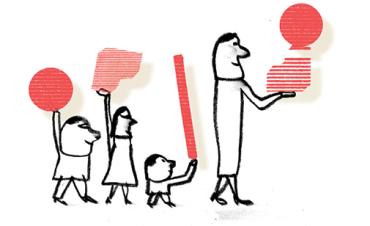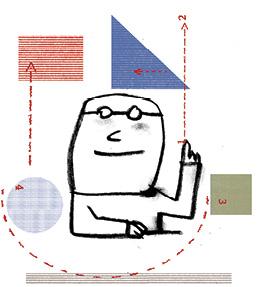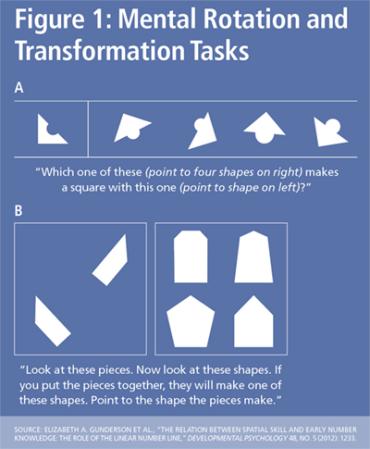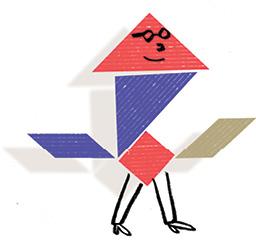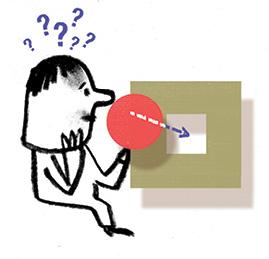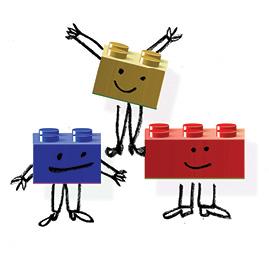Remember the last time you assembled a chest of drawers using that black-and-white IKEA diagram? Or the last time you found your way through a new city without your GPS? In these tasks—and many others—you are using spatial skills. These spatial abilities pervade our everyday lives—whether we are walking to the elevator from a doctor’s office or deftly rotating our hot coffee cups to place them securely on our kitchen counter. The last 15 years have witnessed a quiet revolution in our understanding of spatial skills,* and we are finding that these all-important STEM (science, technology, engineering, and math) competencies are rooted in spatial knowledge. Where would our understanding of DNA be if James Watson and Francis Crick had not imagined a spatial structure like the double helix? Indeed, your spatial ability in high school is related to whether you become an engineer or a lawyer. Your background in spatial experiences predicts your STEM trajectory.
Spatial skills are the tools we use to visualize and navigate the world around us. Spatial skills allow us to manipulate objects in our environment and in our mind. They allow us to compute and store relations between objects, as when we remember we put our keys under the newspaper. Like gravity, we take these skills for granted, although we use them all the time.
Architecture, engineering, dentistry, and medicine are just a few of the fields in which spatial skills are essential. A mistaken measurement on a bridge could be disastrous for commuters. Dentists and doctors routinely interpret X-rays that not only flip left and right, but also present soft tissues as gray and bone as lighter gray. In biology, our understanding of DNA depends on visualizing the double helix. Members of these professions, among others, rely on a foundation of strong spatial skills to accurately and successfully perform their work. So, if spatial skills are so important and pervasive, why are they so little discussed?
Spatial Skills and STEM Readiness
Despite important research findings on the impact of early spatial and math learning on later academic success, many schools lack the knowledge, resources, and capacity to focus on STEM and spatial learning in developmentally appropriate ways.
STEM education in the United States presents a multifaceted challenge. One dimension involves a shortage of classroom teachers who are qualified to teach STEM subjects. According to the Department of Education, during the 2017–2018 school year, public schools in 48 states and the District of Columbia reported teacher shortages in math, and 43 states reported shortages in science.1 This problem may not improve anytime soon, as a study from the University of California, Los Angeles, has found that over the past decade, freshmen’s interest in majoring in education has declined.2
The National Center for Education Statistics reported in 2014 that attrition rates for students pursuing STEM and non-STEM bachelor’s degrees are similar.3 Interestingly, women leaving STEM majors were more likely to switch majors (32 percent of women switched, versus 26 percent of men), whereas men were more likely to drop out of school (24 percent of men dropped out, versus 14 percent of women). A 2013 survey from the National Science Foundation found that, while unemployment rates for STEM majors are low, in many cases those with undergraduate degrees in STEM fields do not end up employed in their field of study.4 The exception to this is computer science, where more than half of graduates are employed in their field.
The picture for math is especially concerning. In 2015, the United States ranked 31st out of 35 developed countries on an international mathematics test of 15-year-olds.5 Only 6 percent scored at or above proficiency level 5, meaning that students can transfer their knowledge to “solve problems that involve visual or spatial reasoning ... in unfamiliar contexts.” Fully 29 percent scored below level 2, meaning they cannot compare the total distance across two alternative routes or compute the approximate price of an object in a different currency. Such findings create a national imperative for more and better training in the STEM disciplines.
Statistics like these prompt experts to highlight the importance of STEM experiences beginning in early childhood, with the goal of enriching spatial and mathematical learning for all children. In 2017, two independent reports from the Joan Ganz Cooney Center, the University of Chicago, and the Erikson Institute argued that early high-quality STEM experiences have a lasting impact on children’s development, consistent with other research findings.6† Though neither of these reports explicitly mentioned spatial skills, a 2018 report from the Center for Childhood Creativity, The Roots of STEM Success: Changing Early Learning Experiences to Build Lifelong Thinking Skills, includes in-depth information on spatial reasoning—the link to math and engineering—and how it can be developed through dialogue.7
The Link between STEM and Spatial Skills
The term STEM was coined in the early 2000s by Judith Ramaley, who served in the directorate at the National Science Foundation.8 Spatial skills have a strong link with performance in STEM fields, and research has consistently shown that early spatial skills predict later success in these disciplines.
In one study, researchers gave high school students four different spatial tests.9 They then linked the students’ spatial scores to the occupations they had 11 years later. Students who pursued STEM-based careers, such as engineering and computer science, had better spatial skills in high school than those who pursued less STEM-focused careers.
STEM accomplishments later in life are facilitated by a mix of intellectually challenging STEM educational opportunities before college. Thus, it is essential to better equip our schools with resources and training so they can provide rich STEM experiences to foster spatial learning and achievement. But this link is not specific to adults, or even high school students. A link between spatial skills and mathematics performance is evident with children as young as preschoolers and elementary school children. In one study, researchers measured the spatial skills of first- and second-grade children at the start of school using a mental transformation test.10 In one task (see task A in Figure 1), children were shown a shape and asked to determine which of the four other shapes, when combined with it, would make a square (the answer: the first shape). In another task (see task B in Figure 1), children were asked what shape on the right would result from combining the two shapes on the left (the answer: the shape on the bottom right).
(click the image above to expand)
The researchers then followed these children’s improvement in number line calculations throughout the school year. Number lines are inherently spatial, though they are typically considered a tool for mathematical support. Children who had better spatial skills at the beginning of the year improved more on number line calculations throughout the school year. Thus, spatial skills are vital for early mathematical calculations; understanding magnitude rests on understanding the number line.
Interestingly, the spatial learning preschoolers acquire through block and puzzle play relates not only to spatial outcomes but also to mathematical learning. Researchers followed children from ages 3 to 5 to examine a possible link between spacial learning and math.11 They used a Test of Spatial Assembly, which involves copying an array of shapes with tangram puzzles or copying a LEGO construction by assembling the LEGO blocks. The children were scored based on how well their construction matched the model. They found that the children who did better on the test at age 3 had higher math readiness scores on standardized math assessments at age 5, when most children start kindergarten. These findings are significant because by kindergarten, children’s math scores can be predicted through high school.
Supporting Spatial Development
By age 3, individual preschoolers already differ in their spatial skills. So where do these differences start? Are some people born with greater spatial abilities than others? Research with babies finds that as early as 5 months, boys are better than girls at recognizing an object presented as a mirror image.12 And one study suggests that spatial differences detected at 7 months predict children’s spatial abilities at 4 years old.13 These studies examined “mental rotation”—the ability to mentally manipulate objects to picture them in differing orientations. As adults, we use mental rotation when we imagine how to position our key to unlock the front door, or when we have to match an image that tells us how to insert our credit card in an ATM.
Many children’s toys provide opportunities to practice this skill. For example, children’s shape sorters involve planning to put a shape into the correct hole, which often requires subsequent physical rotation of the shape. Why is it so easy for adults to fit blocks into shape sorters but so difficult for infants and toddlers? A series of experiments suggests that our ability to manipulate objects flexibly depends on the knowledge that we acquire as young children with objects, actions, and spatial relations.
Apparently, infants can recognize objects that have undergone a rotation.14 However, recognizing objects from different orientations is just the beginning of spatial knowledge. More complex spatial thinking is fostered through language. For example, the language babies receive from their caregivers during play or daily routines that refers to shapes, sizes, features of shapes, and the orientation of shapes helps them connect spatial thinking about objects with the real world.
Researchers who investigated the key role that spatial language plays in helping children make sense of spatial concepts found that children who hear more spatial language, words like “on,” “under,” and “far,” at 14 months of age tend to produce more spatial language later on and perform better on spatial tasks at 4 years of age.15 This is because children who have heard greater spatial talk early in life are more likely to produce spatial language, and, in turn, those children who produce more spatial language are likely to perform better on spatial problem-solving tasks.
Rich spatial language can impact children’s spatial cognition by focusing their attention to spatial information, and thus facilitate their ability to solve spatial problems. Having the words to explain that the slide is on top of the ladder may help a child better understand not only how to get to the slide, but also how to tell a friend to meet him or her there. Adults’ use of spatial language with children while they are building with blocks, working on puzzles, or doing everyday activities appears to provide fuel for spatial knowledge.
Caregivers often use spatial language without even realizing it. Common phrases like “Will you put on your socks?” and “Make sure to step over the cord” have spatial terms embedded in them. Spatial language also emerges during play, but the quality of these interactions depends on the type of toys caregivers and children use. For example, playing with traditional shape toys results in caregivers using more spatial language and more language overall than when playing with electronic shape toys that bark commands, flash lights, play music, or say unrelated things like “I love you.”16
Promoting Spatial Learning
Fortunately, spatial skills are malleable, meaning they can be improved through practice. And there are many ways to promote spatial learning that are quick and inexpensive. How teachers and children engage in spatial play is just as important as the types of activities that are used to promote spatial learning. The science of learning tells us that children benefit from guided play. Guided play occurs when an adult provides support to help children achieve a learning goal. Children take the lead, but adults support their exploration through props and by interacting in ways that scaffold interest and learning.
In one study, researchers taught 4-year-olds the properties of geometric forms (for instance, that a triangle is a triangle because it has three corners and three sides).17 Children were randomly assigned to one of three pedagogical conditions: guided play, didactic instruction, or free play. In the guided play condition, the experimenter and children worked together as detectives to discover “the secrets” of the shapes, or what makes the shapes “real.” The experimenter helped the children discover each shape’s distinguishing features through questions and encouraging the children to touch or trace the shapes presented on cards.
The didactic instruction condition was similar to the guided play condition in that the children were exposed to the same materials, but these children were asked to watch the experimenter play detective. Thus, the children’s engagement differed in that the experimenter acted as the explorer while the children watched and listened. In the free play condition, the children were given the shape cards and a set of construction sticks to play with. The children were then told that Leelu the Ladybug is “a very picky bug who loves shapes, but only real shapes.” The children were then asked to look carefully, identify whether each shape was real or fake, and explain why. Then the children were asked to place the real shapes in Leelu’s box and the fake shapes in the trash can.
After about 15 minutes of shape training, children’s shape knowledge excelled in the guided play condition, compared with those who were just told the secrets (didactic instruction) and those who engaged in free play. Their shape advantage was even maintained after one week. This suggests that a fruitful way of teaching geometric knowledge to young children is through guided play.
To build upon supporting children’s learning through guided play, educators can incorporate project-based learning to encourage spatial and mathematical learning in the early years. Project-based learning is a teaching method where students gain knowledge and skills by working to investigate and respond to a complex problem, question, or challenge.
What might spatial project-based learning look like in a preschool classroom?
Play with wooden blocks, tangram shapes, and everyday objects that are found indoors or outdoors can help develop fine motor, language, social, and cognitive skills. But did you know that they also can provide rich opportunities for preschoolers to learn about shapes through spatial talk and guided play? Shape play can be enriched by drawing upon research that finds spatial language can help improve toddlers’ and preschoolers’ spatial reasoning.
During transition time, present preschoolers with a problem: We need to clean up all the shapes before we can go outside for recess. All the triangles need to go in this basket, and the other shapes need to go in this basket. Ask children to talk about what makes a triangle a triangle, and present them with different variants or nonstandard triangles (e.g., obtuse, scalene, acute). Share the strategy of counting the number of corners, practice it, and then encourage kids to count as they sort. Then ask children if they know another way they can count to figure out the shape (counting the sides). You can even continue the fun outside at recess by asking children to search for different shapes in nature and take pictures or bring them inside to talk about what they found.
Another option is to give students a task with blocks where they need to work together to build a strong structure like a castle or a house. While they are building, ask them about the location of the blocks and encourage their use of spatial prepositions to promote spatial language. Should you put the cube on top of the rectangular prism? Which shape did you put next to the cylinder? Not only are children learning new spatial prepositions, but they are also getting experience with rotating and manipulating the pieces. To make it even more challenging, have your class try to create a replica of a structure from a detailed image or a series of spatial instructions.
What might spatial project-based learning look like in an elementary school classroom?
At one elementary school we visited, classrooms participate in theme-based education. One year, teachers made up a fictional planet: Orbis, which is in a galaxy on the other side of the sun from Earth. Each classroom became a different country and was tasked with survival problems. Lunaguavia is located near an ocean with ports and has a sunny climate that is ideal for growing produce. Interstasis has rich mineral deposits that can be manufactured into products. Each country needs to make collaborative deals with other countries in order to receive goods.
In this classroom lesson masked as playful problem solving, students are communicating and collaborating to help their countries survive while also learning new content. There are a number of ways to incorporate spatial learning into a classroom scenario such as this. Teachers can introduce a map activity where parts of the map of their country are incomplete and children need to identify the missing landmarks around the classroom and complete the map with stickers that correspond to those landmarks. This is a great opportunity for children to write down or discuss what clues they used or why they chose their locations for the stickers. It incorporates perspective-taking and teaches children about paying attention to spatial cues. Then, once the map is completed, children can work on activities or quests that require calculating the size of a boat or the miles needed to travel. As such, project-based learning becomes an exciting and accessible way of teaching core curriculum.
Informal Learning
As it turns out, a large percentage of children’s waking hours (80 percent) is spent outside of school.18 Therefore, it is just as important to promote spatial skill development outside of the classroom. Fortunately, spatial experiences are all around us, whether in a public space like a park, where children can build a bridge with objects found in nature, or in a children’s museum that teaches STEM skills through hands-on activities using technology such as 3D printers. Informal spaces like libraries and grocery stores can also provide multiple opportunities for engaging in spatial experiences early on.
STEM learning can occur whenever children ask or explore answers to a spatial question or problem. Everyday moments like cleaning up toys or eating a meal can provide a rich opportunity for children and adults to play, talk, and interact together around spatial ideas. Spatial talk can also be promoted through an activity such as I SPY! or a board game such as Chutes and Ladders. Additionally, pointing out shapes in everyday life—rectangular doors, square windows, or circular tables—is an easy way to teach children about shapes and shape properties.
One initiative that is working to transform everyday places into learning opportunities is Learning Landscapes, through which many community projects have been developed, including Parkopolis and Urban Thinkscape in Philadelphia. These projects embed playful learning experiences in public spaces like museums, playgrounds, and bus stops. Recent research has found that these projects are significantly increasing spatial talk between children and their parents or guardians.19
Increasing access to a “spatial education” in and out of school can promote both school readiness and long-term performance gains in STEM-related fields. We can continue to draw from a large evidence base about how best to help children develop early spatial skills to lay the foundations for STEM achievement in school and work and better prepare them for the increasingly STEM-centric demands of the world. Now, how do we assemble that dresser?
Laura Zimmermann is an education researcher in SRI International’s Education Division. Lindsey Foster is a language and culture assistant in Madrid, Spain, and was formerly a lab manager in the Child’s Play, Learning, and Development Lab at the University of Delaware. Roberta Michnick Golinkoff is the Unidel H. Rodney Sharp Chair in the School of Education at the University of Delaware, where she directs the Child’s Play, Learning, and Development Lab. Kathy Hirsh-Pasek is the Stanley and Debra Lefkowitz Distinguished Faculty Fellow in the Department of Psychology at Temple University and is a senior fellow at the Brookings Institution.
*For more on spatial skills, see “Picture This” in the Summer 2010 issue of American Educator, available here, and “Seeing Relationships” in the Spring 2013 issue of American Educator, available here. (back to article)
†For more on early high-quality STEM experiences, see “Where’s Spot?: Finding STEM Opportunities for Young Children in Moments of Dramatic Tension” in the Fall 2017 issue of American Educator, available here. (back to article)
Endnotes
1. Freddie Cross, Teacher Shortage Areas Nationwide Listing 1990–1991 through 2017–2018 (Washington, DC: U.S. Department of Education, 2017), www2.ed.gov/about/offices/list/ope/pol/ateachershortageareasreport2017-18.pdf.
2. Leib Sutcher, Linda Darling-Hammond, and Desiree Carver-Thomas, A Coming Crisis in Teaching? Teacher Supply, Demand, and Shortages in the U.S. (Palo Alto, CA: Learning Policy Institute, 2016).
3. Xianglei Chen and Matthew Soldner, STEM Attrition: College Students’ Paths Into and Out of STEM Fields (Washington, DC: U.S. Department of Education, 2013).
4. National Center for Science and Engineering Statistics, “Table 3-2. Broad Occupation Category of Employed U.S. Scientists and Engineers with a Bachelor’s as the Highest Degree, by Field of Highest Degree: 2013,” National Science Foundation, 2015, https://ncsesdata.nsf.gov/us-workforce/2013/html/SES2013_DST_03_2.html.
5. Organization for Economic Cooperation and Development, PISA 2015 Results in Focus, “Snapshot of Performance in Science, Reading and Mathematics” (Paris: OECD, 2018), www.oecd.org/pisa/pisa-2015-results-in-focus.pdf; and National Center for Education Statistics, “Selected Findings from PISA 2015,” http://www.nces.ed.gov/surveys/pisa/pisa2015/pisa2015highlights_1.asp.
6. Elisabeth R. McClure et al., STEM Starts Early: Grounding Science, Technology, Engineering, and Math Education in Early Childhood (New York: Joan Ganz Cooney Center at Sesame Workshop, 2017); and Barbara Bowman et al., Early STEM Matters: Providing High-Quality STEM Experiences for All Young Learners (Chicago: University of Chicago STEM Education and Erikson Institute, January 2017).
7. Helen Shwe Hadani and Elizabeth Rood, The Roots of STEM Success: Changing Early Learning Experiences to Build Lifelong Thinking Skills (Sausalito, CA: Center for Childhood Creativity at the Bay Area Discovery Museum, 2018).
8. Jerome Christenson, “Ramaley Coined STEM Term Now Used Nationwide,” Winona Daily News, November 13, 2011.
9. Jonathan Wai, David Lubinski, and Camilla P. Benbow, “Spatial Ability for STEM Domains: Aligning over 50 Years of Cumulative Psychological Knowledge Solidifies Its Importance,” Journal of Educational Psychology 101, no. 4 (2009): 817–835.
10. Elizabeth A. Gunderson et al., “The Relation between Spatial Skill and Early Number Knowledge: The Role of the Linear Number Line,” Developmental Psychology 48, no. 5 (September 2012): 1229–1241.
11. Brian N. Verdine et al., “Links between Spatial and Mathematical Skills across the Preschool Years,” Monographs of the Society for Research in Child Development 82, no. 1 (March 2017): 1–150.
12. David S. Moore and Scott P. Johnson, “Mental Rotation in Human Infants: A Sex Difference,” Psychological Science 19, no. 11 (November 2008): 1063–1066; and Paul C. Quinn and Lynn S. Liben, “A Sex Difference in Mental Rotation in Infants: Convergent Evidence,” Infancy 19, no. 1 (August 2013): 103–116.
13. Jillian E. Lauer and Stella F. Lourenco, “Spatial Processing in Infancy Predicts Both Spatial and Mathematical Aptitude in Childhood,” Psychological Science 27, no. 10 (October 2016): 1291–1298.
14. Kristin Shutts et al., “Young Children’s Representations of Spatial and Functional Relations between Objects,” Child Development 80, no. 6 (November–December 2009): 1612–1627.
15. Shannon M. Pruden, Susan C. Levine, and Janellen Huttenlocher, “Children’s Spatial Thinking: Does Talk about the Spatial World Matter?,” Developmental Science 14, no. 6 (November 2011): 1417–1430.
16. Jennifer M. Zosh et al., “Talking Shape: Parental Language with Electronic versus Traditional Shape Sorters,” Mind, Brain, and Education 9, no. 3 (2015): 136–144.
17. Kelly R. Fisher et al., “Talking Shape: Supporting Preschoolers’ Acquisition of Geometric Knowledge through Guided Play,” Child Development 84, no. 6 (November–December 2013): 1872–1878.
18. Bob Lenz, “The 80/20 Rule: Changing Mindsets about the Where of Learning,” P21 Blog, June 8, 2015.
19. Brenna Hassinger-Das et al., “Learning Landscapes: Playing the Way to Learning and Engagement in Public Spaces,” Education Sciences 8, no. 2 (2018): 74; and Brenna Hassinger-Das et al., “Urban Thinkscape: Infusing Public Spaces with Learning Opportunities” (manuscript submitted for publication).

